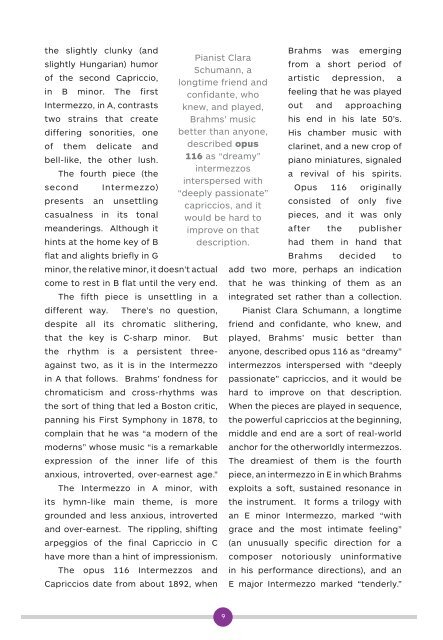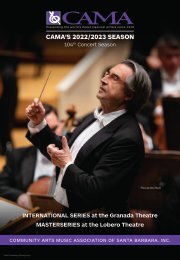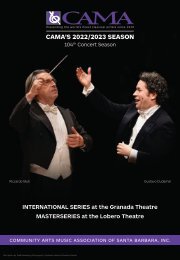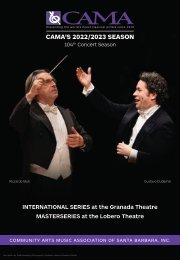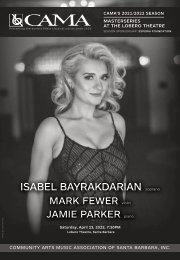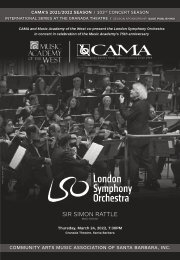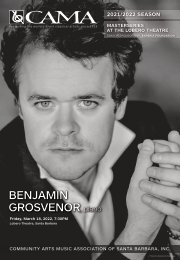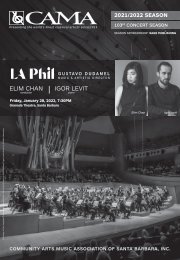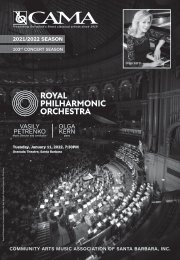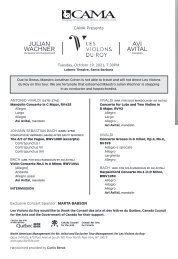CAMA's Masterseries presents Sir András Schiff, piano / April 12, 2018 / Lobero Theatre, Santa Barbara
CAMA's Masterseries presents Sir András Schiff, Piano Thursday, April 12, 2018 Lobero Theatre, 8:00 PM Program: Felix Mendelssohn-Bartholdy: Fantasy in F-sharp minor, Op.28 Ludwig van Beethoven: Sonata No.24 in F-sharp Major, Op.78 Johannes Brahms: 8 Klavierstücke, Op.76 Johannes Brahms: 7 Fantasien, Op.116 Johann Sebastian Bach: English Suite No.6 in D minor, BWV 811 “…so successful was the evening that the critic can only throw up his hands, wish you had been there, and quote Ira Gershwin’s endearing tombstone inscription: ‘Words Fail Me.’” —The New York Times “Listening to Schiff play is like looking into a running stream and seeing all the colorful, round pebbles beneath the water.” —San Jose Mercury “Schiff stands with perhaps only a handful of pianists in his total achievement of the most severe beauty.” —The Philadelphia Inquirer Sir András Schiff is world-renowned and critically acclaimed as a pianist, conductor, pedagogue and lecturer. He returns to Santa Barbara for his seventh Masterseries appearance in recital. Knighted by Queen Elizabeth II for his services to music, Sir András is one of the piano’s true legends. •
CAMA's Masterseries presents
Sir András Schiff, Piano
Thursday, April 12, 2018
Lobero Theatre, 8:00 PM
Program:
Felix Mendelssohn-Bartholdy: Fantasy in F-sharp minor, Op.28
Ludwig van Beethoven: Sonata No.24 in F-sharp Major, Op.78
Johannes Brahms: 8 Klavierstücke, Op.76
Johannes Brahms: 7 Fantasien, Op.116
Johann Sebastian Bach: English Suite No.6 in D minor, BWV 811
“…so successful was the evening that the critic can only throw up his hands, wish you had been there, and quote Ira Gershwin’s endearing tombstone inscription: ‘Words Fail Me.’”
—The New York Times
“Listening to Schiff play is like looking into a running stream and seeing all the colorful, round pebbles beneath the water.”
—San Jose Mercury
“Schiff stands with perhaps only a handful of pianists in his total achievement of the most severe beauty.”
—The Philadelphia Inquirer
Sir András Schiff is world-renowned and critically acclaimed as a pianist, conductor, pedagogue and lecturer. He returns to Santa Barbara for his seventh Masterseries appearance in recital. Knighted by Queen Elizabeth II for his services to music, Sir András is one of the piano’s true legends. •
Create successful ePaper yourself
Turn your PDF publications into a flip-book with our unique Google optimized e-Paper software.
the slightly clunky (and<br />
slightly Hungarian) humor<br />
of the second Capriccio,<br />
in B minor. The first<br />
Intermezzo, in A, contrasts<br />
two strains that create<br />
differing sonorities, one<br />
of them delicate and<br />
bell-like, the other lush.<br />
The fourth piece (the<br />
second<br />
Intermezzo)<br />
<strong>presents</strong> an unsettling<br />
casualness in its tonal<br />
meanderings. Although it<br />
hints at the home key of B<br />
flat and alights briefly in G<br />
minor, the relative minor, it doesn’t actual<br />
come to rest in B flat until the very end.<br />
The fifth piece is unsettling in a<br />
different way.<br />
There’s no question,<br />
despite all its chromatic slithering,<br />
that the key is C-sharp minor. But<br />
the rhythm is a persistent threeagainst<br />
two, as it is in the Intermezzo<br />
in A that follows. Brahms’ fondness for<br />
chromaticism and cross-rhythms was<br />
the sort of thing that led a Boston critic,<br />
panning his First Symphony in 1878, to<br />
complain that he was “a modern of the<br />
moderns” whose music “is a remarkable<br />
expression of the inner life of this<br />
anxious, introverted, over-earnest age.”<br />
The Intermezzo in A minor, with<br />
its hymn-like main theme, is more<br />
grounded and less anxious, introverted<br />
and over-earnest. The rippling, shifting<br />
arpeggios of the final Capriccio in C<br />
have more than a hint of impressionism.<br />
The opus 116 Intermezzos and<br />
Capriccios date from about 1892, when<br />
Pianist Clara<br />
Schumann, a<br />
longtime friend and<br />
confidante, who<br />
knew, and played,<br />
Brahms’ music<br />
better than anyone,<br />
described opus<br />
116 as “dreamy”<br />
intermezzos<br />
interspersed with<br />
“deeply passionate”<br />
capriccios, and it<br />
would be hard to<br />
improve on that<br />
description.<br />
Brahms was emerging<br />
from a short period of<br />
artistic depression, a<br />
feeling that he was played<br />
out and approaching<br />
his end in his late 50’s.<br />
His chamber music with<br />
clarinet, and a new crop of<br />
<strong>piano</strong> miniatures, signaled<br />
a revival of his spirits.<br />
Opus 116 originally<br />
consisted of only five<br />
pieces, and it was only<br />
after the publisher<br />
had them in hand that<br />
Brahms decided to<br />
add two more, perhaps an indication<br />
that he was thinking of them as an<br />
integrated set rather than a collection.<br />
Pianist Clara Schumann, a longtime<br />
friend and confidante, who knew, and<br />
played, Brahms’ music better than<br />
anyone, described opus 116 as “dreamy”<br />
intermezzos interspersed with “deeply<br />
passionate” capriccios, and it would be<br />
hard to improve on that description.<br />
When the pieces are played in sequence,<br />
the powerful capriccios at the beginning,<br />
middle and end are a sort of real-world<br />
anchor for the otherworldly intermezzos.<br />
The dreamiest of them is the fourth<br />
piece, an intermezzo in E in which Brahms<br />
exploits a soft, sustained resonance in<br />
the instrument. It forms a trilogy with<br />
an E minor Intermezzo, marked “with<br />
grace and the most intimate feeling”<br />
(an unusually specific direction for a<br />
composer notoriously uninformative<br />
in his performance directions), and an<br />
E major Intermezzo marked “tenderly.”<br />
9


